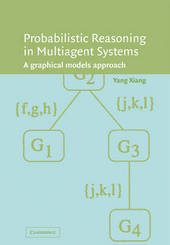
|
Probabilistic Reasoning in Multiagent Systems: A Graphical Models Approach
Paperback / softback
Main Details
| Title |
Probabilistic Reasoning in Multiagent Systems: A Graphical Models Approach
|
| Authors and Contributors |
By (author) Yang Xiang
|
| Physical Properties |
| Format:Paperback / softback | | Pages:308 | | Dimensions(mm): Height 244,Width 170 |
|
| Category/Genre | Probability and statistics
Mathematical theory of computation |
|---|
| ISBN/Barcode |
9780521153904
|
| Classifications | Dewey:006.333 |
|---|
| Audience | | Professional & Vocational | |
|---|
| Illustrations |
Worked examples or Exercises
|
|
Publishing Details |
| Publisher |
Cambridge University Press
|
| Imprint |
Cambridge University Press
|
| Publication Date |
24 June 2010 |
| Publication Country |
United Kingdom
|
Description
This 2002 book investigates the opportunities in building intelligent decision support systems offered by multi-agent distributed probabilistic reasoning. Probabilistic reasoning with graphical models, also known as Bayesian networks or belief networks, has become increasingly an active field of research and practice in artificial intelligence, operations research and statistics. The success of this technique in modeling intelligent decision support systems under the centralized and single-agent paradigm has been striking. Yang Xiang extends graphical dependence models to the distributed and multi-agent paradigm. He identifies the major technical challenges involved in such an endeavor and presents the results. The framework developed in the book allows distributed representation of uncertain knowledge on a large and complex environment embedded in multiple cooperative agents, and effective, exact and distributed probabilistic inference.
ReviewsReview of the hardback: '... this is a valuable and welcome comprehensive guide to the state-of-the-art in applying belief networks.' Kybernetes Review of the hardback: '... the well-balanced treatment of multiagent systems will make the book useful to both theoretical computer scientists and the more applied artificial intelligence community. Moreover, the interdisciplinary nature of the subject makes it relevant not only to computer scientists but also to people from operations research and microeconomics (social choice and game theory in particular). The book easily deserves to be on the shelf of any modern theoretical computer scientist.' SIGACT News
|